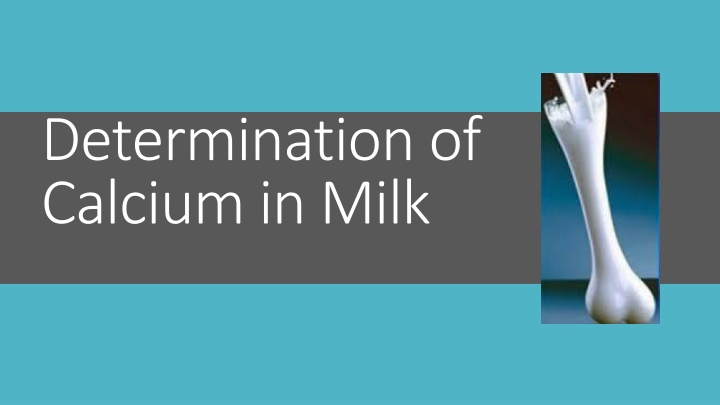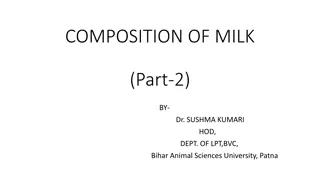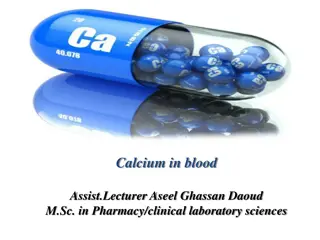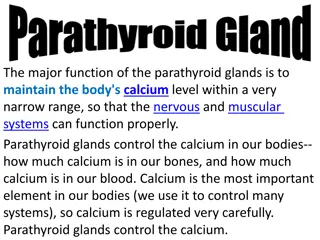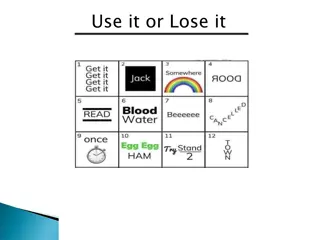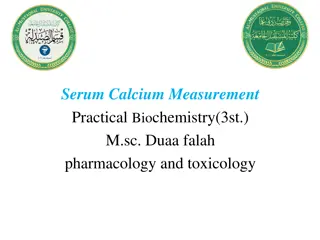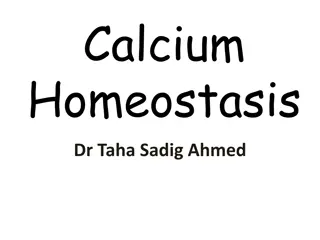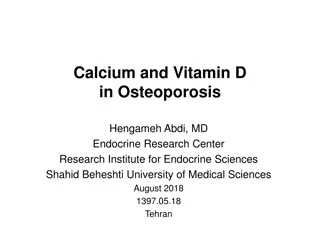Importance of Calcium in Milk for Bone Health
Calcium is a crucial mineral essential for maintaining strong bones and teeth, muscle function, and blood circulation. This article discusses the significance of calcium, recommended daily intakes, sources of calcium in milk, and a complexometric titration method for determining calcium levels. Milk stands out as a natural source of calcium with good bioavailability, making it an important dietary component for meeting calcium requirements.
Download Presentation

Please find below an Image/Link to download the presentation.
The content on the website is provided AS IS for your information and personal use only. It may not be sold, licensed, or shared on other websites without obtaining consent from the author.If you encounter any issues during the download, it is possible that the publisher has removed the file from their server.
You are allowed to download the files provided on this website for personal or commercial use, subject to the condition that they are used lawfully. All files are the property of their respective owners.
The content on the website is provided AS IS for your information and personal use only. It may not be sold, licensed, or shared on other websites without obtaining consent from the author.
E N D
Presentation Transcript
Determination of Calcium in Milk
Calcium an important mineral for the body Calcium is an important component of a healthy diet and a mineral necessary for life. Calcium is a mineral that people need to build and maintain strong bones and teeth. It is also very important for other physical functions, such as muscle control and blood circulation If we do not have enough calcium in our diets to keep our bodies functioning, calcium is removed from where it is stored in our bones. Over time, this causes our bones to grow weaker and may lead to osteoporosis a disorder in which bones become very fragile.
Recommended Daily Allowance of Calcium Calcium needs vary with age. The Food and Nutrition Board (FNB) of the Institute of Medicine of the Calcium needs vary with age. The Food and Nutrition Board (FNB) of the Institute of Medicine of the National Academies provides guidelines on the amount of calcium needed each day. National Academies provides guidelines on the amount of calcium needed each day. Recommended Daily Allowance in Milligrams (mg) Life Stage Group Life Stage Group Recommended Daily Calcium Intake Recommended Daily Calcium Intake Women and men 9 to 18 years 1,300 mg Women and men 19 to 50 years 1,000 mg Women 51 to 70 years 1,200 mg Men 51 to 70 years 1,000 mg Women and men > 70 years 1,200 mg Pregnant or nursing women 14 to 18 years 1,300 mg Pregnant or nursing women 19 to 50 years 1,000 mg
Milk and calcium Milk is a heterogeneous mixture of proteins, sugar, fat, vitamins and minerals. Milk and milk products are some of the natural sources of calcium. Cow s milk has good bioavailability of calcium (about 30 to 35%). Milk is an excellent source of dietary calcium for those whose bodies tolerate it because it has a high concentration of calcium and the calcium in milk is excellently absorbed. It is estimated that without milk and milk products in the diet, less than half of the calcium requirements would be met.
Principle In this experiment, The determination of calcium in milk is based on a complexometric complexometric titration titration of calcium with an aqueous solution of the disodium salt of EDTA at high pH value (12) . Complexometric titration is a type of titration based on complex formation between the analyte and titrant. Such compounds are capable of forming chelate complexes with many cations in which the cation is bound in a ring structure. The ring results from the formation of a salt-like bond between the cation and the carboxyl groups together with a coordinate bond through the lone pair of electrons of the nitrogen atom.
Principle-cont The common form of the agent is disodium salt Na2H2EDTA. Itis colorless. It can be weighed and dissolve in water to form a stable solution. At high pH (> 10) the remaining protons leave EDTA forming EDTA4- anion:
Principle How to How to determin determin calcium in the presence of Mg? calcium in the presence of Mg? This method for determining Ca2+concentration in the presence of Mg2+relies on the fact that the pH of the solution is sufficiently high ((The pH will be approximately 12.5 due to the addition of concentrated NaOH solution)) to ensure that all magnesium ions precipitate as magnesium hydroxide before the indicator is added. In this condition, magnesium ions are precipitated as hydroxide and do not interfere with the determination of calcium.
Indicator-Solochrome dark blue The Solochrome dark blue indicator is a suitable indicator in this case as it produces. The dye itself has a blue color. This blue dye also forms a complex with the calcium ions changing colour from blue to pink/red in the process, but the dye metal ion complex is less stable than the EDTA metal ion complex. As a result, when the calcium ion calcium ion dye dye complex is titrated with EDTA the Ca2+ions react to form a stronger complex with the EDTA changing the dye color to blue. Ca-Indicator + EDTA4- Ca-EDTA2-+ Indicator
Method Combine 10mL of sample, 40mL distilled water, and 4mL of 8M sodium hydroxide solution into an Erlenmeyer flask and allow solution to stand for about 5 minutes with occasional swirling. A small of magnesium hydroxide may precipitate during this time. Do not add the indicator until you have given this precipitate a chance to form. Then add 6 drops of the Solochrome dark blue solution After that start to titrate with EDTA solution Repeat titration for three trials
Calculation 1. Calculate the average volume of EDTA solution used from titres. 2. Calculate the moles of EDTA required to complex the Ca2+ ions in the sample. 3. Calculate the concentration, in mg/L, of Ca2+in your sample solution. That you added from That you added from burette burette Conc. Of EDTA That you Conc. Of EDTA That you used for titration used for titration Calcium Mw Calcium Mw Amount of calcium= ???????? ?? ???? ? ???.?? ???? (?? ?????) ? 40.078 ? 100 Amount of calcium ?????? ?? ?????? The original sample The original sample wieght wieght=5 ml =5 ml
